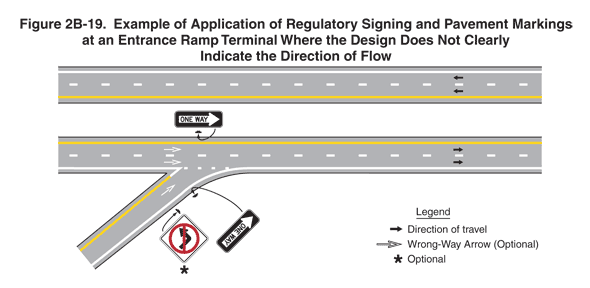|
|
2009 Edition Part 2 Figure 2B-19. Example of Application of Regulatory Signing and Pavement Markings at an Entrance Ramp Terminal Where the Design Does Not Clearly Indicate the Direction of Flow

Figure 2B-19. Example of Application of Regulatory Signing and Pavement Markings at an Entrance Ramp Terminal Where the Design Does Not Clearly Indicate the Direction of Flow
This figure illustrates an example of applying regulatory signing and pavement markings at an entrance ramp terminal where the design does not clearly indicate the direction of flow.
The figure shows a horizontal four-lane divided highway. Arrows show that the direction of travel is two lanes of traffic in each direction.
A legend shows a black arrow indicating the direction of travel on the highway, an outline arrow to show an optional wrong-way arrow, and an asterisk to indicate optional.
A solid yellow line separates the leftmost lane of each direction of travel and the travel lane of the entrance ramp from the adjacent (left) shoulder. A broken white line separates the two lanes of each directional roadway. A solid white line separates the rightmost lane of each direction of travel and the travel lane of the entrance ramp from the adjacent (right) shoulder.
At the bottom left of the eastbound roadway, an entrance ramp is shown intersecting and merging with the roadway at about a 45-degree angle. On the right side of the entrance ramp where it joins the roadway, two signs are shown: (1) a square white sign with a left-pointing right-angle arrow with a diagonal red slash across it, facing the traffic on the entrance ramp and marked with an asterisk, and (2) a horizontal rectangular sign with a white horizontal left-pointing arrow on which the words "ONE WAY" are superimposed, with the sign face shown parallel to the direction of travel on the entrance ramp. A white wrong-way arrow is shown on the pavement between these two signs.
On the median between the two sections of the roadway, a horizontal rectangular black sign is shown with the words "ONE WAY" in black on a white arrow pointing to the right. It is shown placed opposite the point where the entrance ramp joins the roadway and is shown with the face of the sign parallel to the roadway. On the eastbound roadway, a white wrong-way arrow is shown on the pavement in each lane where the entrance ramp joins the highway.
